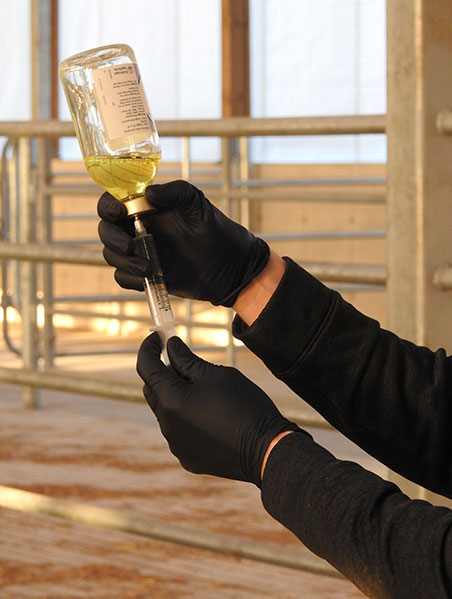Section 3 | Porcine Respiratory Disease
Industry
Page 13 /
Treatment of PRD
Antimicrobials
In Canada, there are a wide variety of drugs available for treating PRD. As always, your veterinarian is the number one resource to help you decide the optimal treatment protocol for your herd.

With an added emphasis on antimicrobial resistance (AMR) due to antimicrobial use in agriculture, it is important to view the science in this light. The best way we know to reduce the likelihood of AMR development to a drug is to use it sparingly — only when absolutely necessary (remember the 5 R’s of antimicrobial use!), and use it as directed by your veterinarian.
When designing therapeutic protocols, engage your herd veterinarian and perform diagnostic testing to develop an understanding of the pathogen profile of your farm, as well as the antimicrobial sensitivity of the bacteria. You can then tailor your strategies to ensure treatment success. Antimicrobial therapy will only be effective if the primary pathogens responsible for causing disease in your herd are bacterial. Armed with this knowledge and the latest science, you can develop a strategy that will have the most success at the least risk of AMR development.
Anti-Inflammatory Drugs
Judicious use of antimicrobials when treating PRD may be aided by adjunct (additional) therapeutics. While well-controlled clinical trials are scarce, there is some evidence that nonsteroidal anti-inflammatory drugs (NSAIDS, such as meloxicam or ketoprofen) reduce the clinical signs (e.g. fever and inappetence) associated with PRD2. One study found that when meloxicam was used in conjunction with an antimicrobial medication to treat PRD, there were less re-treated pigs, mortality was lower, and growth was better compared to animals treated with antimicrobials alone3.
The use of NSAIDs against PRD could reduce inflammation in the pig’s respiratory tract. This, in turn, may reduce fever, as well as make the pig feel better and eat more, thus fueling their immune systems to fight off the infection more efficiently. All these potential positives may act to reduce the total amount of antimicrobials you need in your operation.

Source: ACER Consulting Ltd.
References
- O’Connor, A.M., S.C. Totton, and D. Shane. 2019. A systematic review and network meta-analysis of injectable antibiotic treatment options for naturally occurring swine respiratory disease. J. Swine Heal. Prod. 27:133–149.
- Schoos, A., M. Devreese, and D.G.D. Maes. 2019. Use of non-steroidal anti-inflammatory drugs in porcine health management. Vet. Rec.. doi:10.1136/vr.105170.
- Georgoulakis, I.E., E. Petridou, G. Filiousis, C. Alexopoulos, S.C. Kyriakis, and I. Papatsas. 2006. Meloxicam as adjunctive therapy in treatment and control of porcine respiratory disease complex in growing pigs. J. Swine Heal. Prod. 14:253–257.